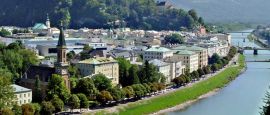Salzburg's chief landmark has a history going back to 1077. Guarding the city from high above, this extraordinary building is the largest fully-preserved fortress in Central Europe. It can be accessed by using the funicular railway (festungsbahn) up the hillside from Festungsgasse 4. Don’t miss the prince-archbishops’ apartments and fortress museum.
Things to see in Salzburg
Tourist offices
Opening Hours:
Daily 0900-1800 (Apr-Jun); Daily 0900-1830 (Jul); Daily 0900-1900 (Aug); Daily 0900-1830 (1 Sep-8 Sep); Daily 0900-1800 (9 Sep-16 Oct); Mon-Sat (17 Oct-31 Mar).
www.salzburg.infoSalzburg's official tourist office is supplemented by additional tourist offices at street level dealing directly with any queries from tourists. There is one at Mozartplatz 5 (tel: +43 662 8898 7330) and another on platform 2A at the central railway station (tel: +43 662 8898 7340), both of which are open all year round.
The Salzburg Card (valid either for 24, 48 or 72 hours) includes free admission to all the city's attractions and free use of public transport (including the fortress funicular, the panorama boat on the river and the Untersberg cable car) as well as discounts for cultural events and for various tours and excursions. You can pick one up at all customer service centres, in hotels and at tourist information booths.
Salzburg’s beautiful cathedral is one of the most significant pieces of early baroque architecture in Europe. The first cathedral was built here in the 8th century, but was rebuilt twice over the centuries. It survived a direct hit during WWII when a bomb struck its dome but did little other damage. Highlights inside include the font in which Mozart was baptised.
Salzburg’s historic monastery has its roots in the earliest monastic community in the German-speaking world, founded by the Frankish missionary St Rubert after he arrived in Salzburg in the early 8th century. St Peter’s Abbey is one of the main attractions in the city with its gorgeous Romanesque interior. There are also catacombs, probably of early Christian origin, in the area.
As well as the Salzburg Residenz, the DomQuartier holds the stunning Cathedral Museum which is full of religious icons and artistry and has unique views of the cathedral itself. The Cabinet of Curiosities, meanwhile, is a quirky museum dedicated to obscure prizes and rare oddities; such displays were popular in the Baroque era.
The Getreidegasse is the most famous shopping street in Salzburg. Aside from its stock of modern boutiques, jewellery and clothing shops, it’s also the city’s traditional commercial centre, so pretty narrow houses with iron guild signs overlook little passageways and courtyards. This is also where you’ll also find Mozart’s birthplace.
Wolfgang Mozart was born on the third floor of the Hagenauer House on 27th January 1756. The geburthaus, or birthplace of the musical genius, has been revered since 1880 when the International Mozarteum Foundation first established a museum here. Today it exhibits items from Mozart's childhood, including his violin and several other instruments.
Salzburg may be steeped in tradition and history but it also hosts one of the boldest and most impressive contemporary art galleries in Austria. Opened in 2004, the Museum of Modern Art Salzburg can be reached by elevator on a steep hill opposite the fortress and features all kinds of mind-boggling installations, video art and controversial efforts by big-name artists.
This interesting modern museum seeks to tell the story of Salzburg’s history and culture in novel ways. The first floor features exhibitions on important architects, writers and scientists of the city, while the second floor deals with the city’s history. Archaeological finds and medieval collections can be found in the Mirror Hall.
The former official apartments of the Salzburg prince-archbishops still make up an impressively lavish building complex, which have benefited from the work of Renaissance and baroque artists and architects. One of its highlights is the Residenz Gallery, which boasts an excellent collection of masterpieces by Rembrandt, Rubens and Brueghel.
Guided tours are given (once daily in winter, twice in June and September, and three times in July and August) of Salzburg's splendid and world-famous Festival Halls, where all main ballet, opera and musical concerts during the Salzburg Festival are performed. The establishment of the Salzburg Festival in 1920 turned the city into an artistic beacon.
Do you have any Feedback about this page?
© 2025 Columbus Travel Media Ltd. All rights reserved. No part of this site may be reproduced without our written permission, click here for information on Columbus Content Solutions.








 You know where
You know where